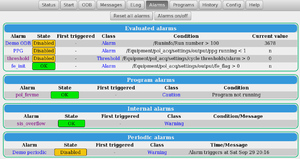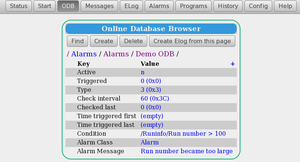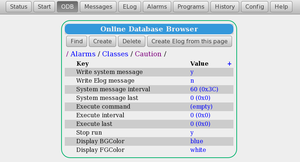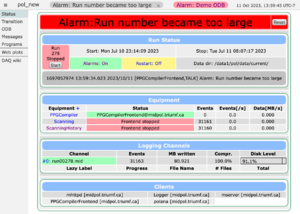Alarms Page
Links
Purpose
The purpose of the mhttpd Alarms page is to display information about the MIDAS Alarm System, and to allow the user to reset individual alarms or all alarms.
Access the Alarms page
The Alarms Page is accessed from the Status Page (or any of the other Pages) by clicking on the menu-button Alarms. The top level ODB trees will be visible as key-links (i.e.links to a key) (Figure 1).
Features of the Alarms page
Click to enlarge thumbnails.
Figure 1 shows an example of the Alarms Page. No alarms are triggered. The page displays information from the /Alarms ODB tree. The Alarms Page is divided into four areas, one for each of the alarm types (Evaluated,Program,Internal and Periodic). Clicking on one of the alarm-links on the left hand side of the page (under heading "Alarm") switches to the ODB Page displaying the contents of the /Alarms/Alarms/<alarm-name> subtree. For example, Figure 2 shows the Demo ODB alarm subtree.
In Figure 1, the Demo ODB is shown as Disabled because the key /Alarms ODB tree#Active is set to "n". The Condition shown reflects the Condition key. Current value shows the current value of the Condition. The Class for each alarm is shown as a link under the Class heading. Clicking on one of the class-links switches to the ODB Page displaying the contents of the /Alarms/Alarms/<class-name> subtree. For example, Figure 3 shows the "Caution" class subtree.
Figure 4 shows an example of the Alarms page with an alarm triggered. This causes an alarm banner to appear on the Status Page (see Figure 5).




